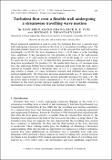Turbulent Flow over a Flexible Wall Undergoing a Streamwise Traveling Wavy Motion
Author(s)
Shen, Lian; Zhang, Xiang; Yue, Dick K.P.; Triantafyllou, Michael S.
DownloadTriantafyllou_2003_Turbulent.pdf (472.9Kb)
Terms of use
Metadata
Show full item recordAbstract
Direct numerical simulation is used to study the turbulent flow over a smooth wavy
wall undergoing transverse motion in the form of a streamwise travelling wave. The
Reynolds number based on the mean velocity U of the external flow and wall motion
wavelength λ is 10 170; the wave steepness is 2πa/λ = 0.25 where a is the travelling
wave amplitude. A key parameter for this problem is the ratio of the wall motion
phase speed c to U, and results are obtained for c/U in the range of −1.0 to 2.0 at
0.2 intervals. For negative c/U, we find that flow separation is enhanced and a large
drag force is produced. For positive c/U, the results show that as c/U increases from
zero, the separation bubble moves further upstream and away from the wall, and is
reduced in strength. Above a threshold value of c/U ≈ 1, separation is eliminated;
and, relative to small- c/U cases, turbulence intensity and turbulent shear stress are
reduced significantly. The drag force decreases monotonically as c/U increases while the power required for the transverse motion generally increases for large c/U; the
net power input is found to reach a minimum at c/U ≈ 1.2 (for fixed U). The results
obtained in this study provide physical insight into the study of fish-like swimming
mechanisms in terms of drag reduction and optimal propulsive efficiency.
Date issued
2003Department
Massachusetts Institute of Technology. Department of Mechanical EngineeringPublisher
Cambridge University Press
Citation
Journal of Fluid Mechanics, 484, p.197-221 (2003)
Keywords
Turbulence, reynolds number, numerical simulation